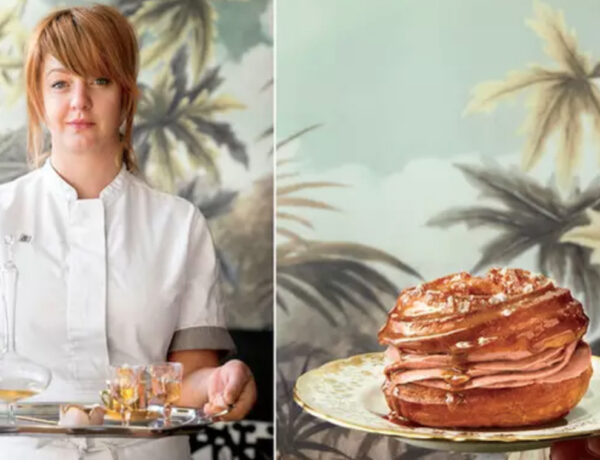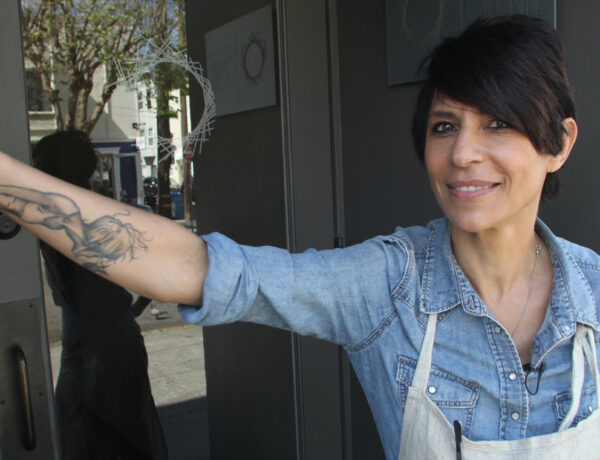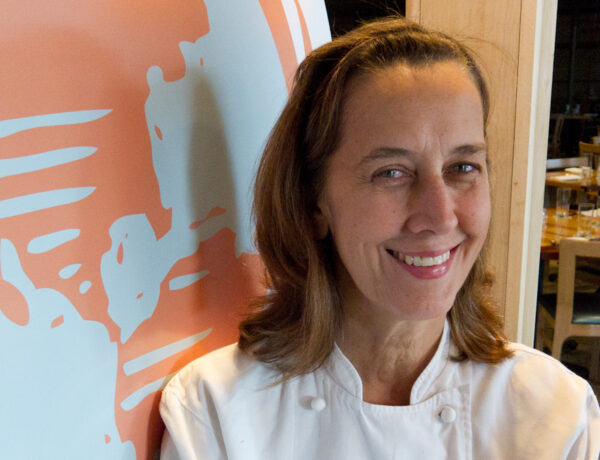Updated January 3, 2020

Chef Victoria Blamey is known for her culinary imagination. Now the executive chef of the iconic New York City staple, Gotham Bar and Grill, Victoria is fast becoming a herald of change in the foodservice industry. Since taking over Gotham from Alfred Portale shortly after our initial interview with her in the spring of 2019, Victoria has boldly led the restaurant into new territories – all while maintaining the restaurant’s 3-star rating from the NY Times. Her new menu celebrates the multiculturalism of the city and sustainably-sourced ingredients.
In this interview, the renowned chef shares her experience trotting the globe via Michelin-starred kitchens, drawing inspiration from diversity, and rethinking food waste.
In the past year since moving on from Chumley’s, what have you been up to? Any upcoming projects near and dear to you that you can tell us about?
It’s funny, it feels way longer for me than it actually has been—I left a little over a year ago. At first it was difficult to grasp—I’m not good at not working in a restaurant!—but I’ve been lucky in that a lot of projects came my way right after I left. I did some traveling, collaborations with other chefs, worked some pop-ups, was invited to Play with Fire, and got to be on Iron Chef.
Yeah, I’ve been really lucky. We were so busy and understaffed at the restaurant—I think that if I had still been there, I would not have been able to do these things. Pop-ups and events outside of a restaurant sound cool, but they’re really a lot of work—it’s actually harder than working in a restaurant. Most of the time, there’s nowhere to prep, nowhere to get product, and you scramble like crazy to make it work. So that was hard, but an interesting experience.
As a chef, it’s very important to think about food scraps not as waste – but as something we can be utilizing instead.
I recently did a dinner with the James Beard Foundation for Rethink Food NYC. Food waste is a subject that is important to me. As a chef, it’s very important to think about food scraps not as waste but as something we can be utilizing instead. We deal with so many by-products of food and you can do so much more with food scraps than just compost. You don’t really get to have this conversation in culinary school—at least, I didn’t 15, 20 years ago. I think it’s really important to have this conversation as a part of culinary education and then continue having it in our restaurants.
In general, people have been approaching me for different projects, but I’m really looking for longevity more than just a job.
Let’s talk about your journey as a chef. You’re an immigrant to the U.S., a person of color, and a woman—three huge hurdles to overcome in an industry that is so dominated by white men. Tell us a little bit about your experience and the challenges you’ve faced in this industry over the last 15 years.
You know, I don’t really think about it that way. I don’t know if it’s just women of my generation or what, but I don’t think, “Oh my god, I’m a woman and I’m Latina and I am here.” I’ve just always thought, “This is what I want to do, I should have the same opportunity here as anyone else.”
I realize I’m unique. I grew up with my mom in Chile as an only child—she had me when she was really young. She works for a huge multinational company and growing up with her, I saw the struggles of inequality of payment between women and men. While I haven’t necessarily experienced that in my career, I do still have that chip ingrained of: “I need to try harder, I do need to double the work. If someone needs to stay late, I’ll stay later, if someone needs to go in early, I’ll go in earlier. I’m not gonna ask for help, I’m not gonna ask for someone to carry anything for me.” I think that’s what I had envisioned it would be like as a woman starting in the business—like, physically I need to be stronger. I can do the same as a man but I need to make sure I prove that by being like a rock. That’s what I did and what I still do—though, of course, now in different ways.
It’s probably different for different generations. Something like sexual harassment, I didn’t really pay too much attention to it. In looking back though, I realize it’s been happening to me throughout my entire career. You know, now I think, “Oh my god, that was sexual harassment?” It was never anything too uncomfortable – more like, an invasion of space. I would always try to brush it off with a joke. It was a way to defend myself. Generally, women try to be the hero. We have to be strong to be cut out for this job. I’m not saying you have to behave like a man, but you have to remember that we are still being judged based on gender.
How we work as chefs—it’s consuming. It’s literally the role of surviving. You survive situations that are uncomfortable or situations that are hard. We work with a cold, we work with a broken arm, we work with a burn or a cut, you know? I’m not the person to be like, “Oh, I’m gonna stay at home because I have a cold and I don’t feel well.” I think it’s that way for everyone in this business, for both women and men.
What does being a woman in the foodservice industry mean to you? As you’ve become more seasoned, how has this perspective changed throughout your career?
I think we [female chefs] see ourselves almost as a-gendered at some point in our career. I was in a documentary last year called “The Heat,” with very interesting women, all very high-profile chefs. While I did not necessarily know any of them that well, we all admitted that we don’t think about gender in the kitchen. If we want to hire someone, we want to hire the best; if we do something, we want to do our best. We’re not thinking about who’s a man or who’s a woman. There’s this incredibly high standard that we hold for everyone in the industry.
How do we make room for women now to have the opportunities we didn’t have?
But, at the same time, we find ourselves asking, “How do we make room for women now to have the opportunities we didn’t have?” I’m still asking myself that question. It’s just something that no one really gave us the space to do back in the day. No one cared about how it felt to be a woman in foodservice. At the time, we didn’t want to think about it because we were supposed to be the same as the guys. And that’s the thing—we wanted to be noticed because of our work—not because of our gender, not because we might be pretty, or because of anything physical. We just knew we’d have to try harder to be noticed for the same work and we did.
My perspective has changed very recently – I’ve become more aware and, in a way, I have become more skeptical. Less trusting of people. I am trying to understand how to behave in an industry where injustices happen. I want to try to change that—though I’m not quite sure how you do it. I’ve also become more curious about other women’s experiences. You know, there’s sometimes a breach between women and our hearts in the way we interact with each other, and I want to bridge that. I can’t put my finger on it yet, but I want to figure out how to interpret that experience as a female. I think having more panels and conferences for women in the industry to connect and talk about their experiences is important.
You’ve worked in kitchens in Chile, the U.K., Australia and the U.S.—tell me about the differences in kitchen culture in each country? Did you run into any gender-based challenges? How did you handle that?
I was recently on a panel and the topic was kitchen culture, and I had to really think about my experiences in different kitchens. When asked, “What was the best kitchen you ever worked in?” I thought: I don’t think that there’s a period in my career where I could say, “Wow those 2½ years were amazing.” I think that would be a lie. Everyone knows that working in a kitchen is really hard, especially in the beginning. But you have to develop a thick skin.
For me, Australia was a little difficult—it was the only time that I experienced racism in the kitchen. You know, people are always a little shocked when I say this, but it’s true. There were many reasons why I didn’t like it there, but one of the main reasons is that it was hard to talk to and meet people—you know, between your accent and your look or whatever. It was a very racist community at the time—for me, at least.
Working in a kitchen is hard. As you move up and have some kind of notoriety, sometimes people can be kind of jealous. I was lucky—I didn’t experience anyone judging me out loud because I was a woman or an immigrant—at least, not to my face. It happened only once in England, many years ago. There was this guy who said to me “So you’re here stealing jobs in England.” I looked at him and said, “Why would you say that?” I had a very sweet [male] workmate who straight away defended me, saying, “She’s amazing. She does a better job than many of the lads right here.”
What inspiration do you draw from as a culinary innovator? Do the places you’ve lived in inspire you? What about outside of food?
Different cultures inspire me. Colors inspire me. Travel inspires me. That’s what really excited me when I left Chile the first time at 18—I like discovering things that are completely different from who I am or what I’ve had or what I’ve seen. That‘s one of the things I love about living in a cosmopolitan city—I love diversity.
In general, I draw inspiration from the memories and the past—my childhood, old traditions, and old glamour—finding the story in things you didn’t know were there. While in Chile recently, I read a couple of books about how people used to eat in the sixties. I also get very inspired by food that’s around me—like street food! I love food, I love eating, so I like to be inspired by my food memories. With something like the Chumley burger, I was inspired by my love of bone marrow. It’s a unique flavor—you can’t really taste or duplicate it unless you have it. So I kept thinking, “How can I add bone marrow into a patty?” And that’s how I came up with it. I thought, “Well, this should work,” and funnily enough, it did.
What advice would you give to women just getting started in this industry or who are facing challenges in getting started? Are there resources you can recommend for those looking to build their skill set and keep aware of less traditional foodservice opportunities?
The best advice I was ever given is something Matt Lightner said to me. He said: “When it feels like you’re trying too hard, just leave it there and come back later.” You know when you’re forcing something. Sometimes you can be inspired, but when you get to the kitchen, your idea is not quite there. You can keep pushing it, but sometimes it’s best to just walk away and pick it up again after a week or a month or even a year.
Another thing I would say to anyone starting out in this industry is, “Don’t give up easily!” I’m not going to be super-romantic about this and say that things are way better than they were 20 years ago in foodservice. I mean, I don’t come from the 1960s, so I’m sure if I were to talk to Alice Waters she would say “Oh, it has changed.” And I’m sure things have changed, though maybe not as rapidly as we would like. The difficulties are still here—they’re not gonna go away. They’re still here for me. They just have a different name, another face. You know, especially with foodservice, it’s always going to be a little bit difficult, but it doesn’t mean you have to quit. Find what you love and stick to it.
It’s also so important to network, to not be afraid to reach out to people and ask questions. One of the things that I did—and this was prior to the internet era—was send letters. I would send letters to get every single internship I applied for. I was super perseverant about it. I did my research and wrote my letters. Even in 2003 or so when there was email, I’d send both an email and a letter—and people would actually reply to my letter! Especially in England, people were way more formal and the letter was just something that everyone replied to. It’s much easier now to connect with social media and email.
Do your research and don’t be afraid to reach out and ask your questions. You can’t be afraid of being told no.
What are you most excited about when it comes to the future of the foodservice industry?
I’m excited for chefs to play a bigger role in contributing to society and shaping the next generation of chefs to think sustainably. I think sustainability is going to be the main thing for us to focus on in the future of food. Restaurants need to take a moment to have an open conversation about food waste and really think about where our produce comes from and how we, as chefs, can better utilize our resources and understand our impact on the environment. We can work with seed growers and farmers to grow more diverse, flavorful breeds of produce and animals.
The conversation needs to start with asking: “Okay, how do I see the food waste not as waste but a resource? How can we use every part of the vegetable or animal?” You know, I’m probably not going to do anything with eggshells other than compost them—but there is a lot of opportunity to get creative here. In Spain, some chefs have started frying their kombucha scobys—it’s just pure cellulose. A friend brought me her fried scoby to try—she infused it with freeze-dried strawberries and it was amazing! Had like a tempeh or squid-like texture and was really delicious.
Sustainability is something that needs to be a part of our culinary education and our kitchen culture.
Sometimes our industry touches the surface of something and then it gets very trendy—but we need to dig deeper here. Sustainability is something that needs to be a part of our culinary education and our kitchen culture. I went to school in Chile and I’m not sure what they’re teaching now in culinary school, but sustainability and utilizing food scraps was not something that we learned. I think it’s going to take a great amount of education. But this is something that’s going to affect us in twenty, thirty, fifty years.
There is still such a huge disconnect for chefs between realizing where your product comes from or was grown and how it gets to your restaurant. Especially here in New York, it’s hard to stop and think about sustainability. Everyone is just trying to survive with minimum wages going up and rents going up—it’s like we’re all just waiting for the atomic bomb hit and wondering who’s going to be the last zombie alive? We’re waiting it out to see if it will get better. But food waste is a subject that can help us make better decisions now for our businesses and for the environment!
About Victoria Blamey
Originally from Santiago, Chile, Chef Blamey has traveled the world’s kitchens, cooking in Michelin-starred restaurants in the U.K., Spain, Australia and the U.S. Her career began in England, with a stint under Chef John Campbell at the two-Michelin-starred The Vineyard at Stockcross. She went on to Interlude in Melbourne, Australia, as chef de partie before moving to San Sebastian, Spain, to work with Chef Andoni Luis Aduriz’s Mugaritz, one of the most acclaimed restaurants in the world. She spent some time honing her pastry skills at Wylie Dufresne’s WD-50 in New York City and ABaC in Barcelona. Since 2010, she’s worked in some of the most lauded restaurants across the U.S. under visionary chefs: as chef de partie and chef de cuisine for Paul Liebrant at Corton; as sous chef to Chef Matt Lightner at Atera; and then as both sous chef and chef de cuisine to Chef Justin Smillie at il Buco Alimentari e Vineria and Upland. In 2016 she reopened Chumley’s as the iconic tavern’s executive chef, where she was lauded for her ingenious bone marrow burger. Chef Blamey is now the executive chef of Gotham Bar and Grill in New York City.





